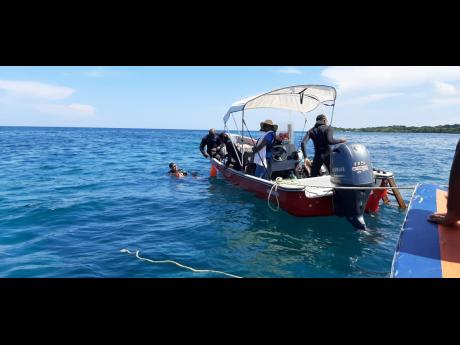Negril reef gets major boost
WESTERN BUREAU:
The coral reef in Negril, Westmoreland, has received a major injection with the planting of 150 pieces of coral in the Orange Bay Fish Sanctuary on International Coastal Clean-up Day (ICCD), which was observed last Friday.
With this year’s ICCD focus on restoring the coral reefs – which are being destroyed by coral disease, pollution, overfishing, and other environmental stressors – the coral planting exercise and other events, which were postponed from September 19 because of rising COVID-19 cases, fell in line.
Loureene Jones, project manager for the Integrating Water, Land and Ecosystems Management in the Caribbean Small Island Developing States, which did the project in partnership with the National Environment and Planning Agency and the Negril Area Environmental Protection Trust (NEPT), explained that they were planting two endangered corals found to survive in deep waters for many years.
The project is being funded by the Global Environment Facility and the UN Environment Programme with support from the Government at a combined cost of US$13 million.
Severe degradation
Jones said the coral reefs in Negril and its environs have been experiencing severe levels of degradation due to indiscriminate fishing, land pollution, and natural disasters.
“We thought this was apt as NEPT is the manager of the fish sanctuary, where the coral nursery is located, so they are doing activities to conserve the reef species,” Jones said of the four-year planting project, which commenced in 2018.
“When the corals are grown to a certain size, then they are defragmented and placed on the reef to rebuild that reef area, so we can restore biodiversity and bring back the natural function,” she told journalists on a ICCD boat tour, explaining that corals are also critical to coastal protection.
The project’s ridge to reef concept covers the activities on land and sea, she said. It is designed to restore the biodiversity of the Negril Great Morass and to restore the hydrology, which is to get back the water level balance so that the natural ecosystem will regenerate and return to its functional uses.
“The hydrology consultancy has already commenced. A study is being done to determine the best solution to re-wet and restore the hydrology of the morass. We also have a wetlands conservation plan that is being developed for the (Negril) Morass and also for the other wetlands that are in the NEPT area,” Jones added.
NEPT Executive Director Keisha Spencer said the transplanting of corals from its nursery to the reef is a crucial step towards maintaining healthy marine ecosystems in the Negril area and serves as a buffer to the declining coral reef population.
“This is our second out-planting exercise where we have planted fragments from our nursery to the reef. The target number that we aimed for was 150 pieces to be planted out on the reef as part of our coral-restoration activities,” Spencer explained.

